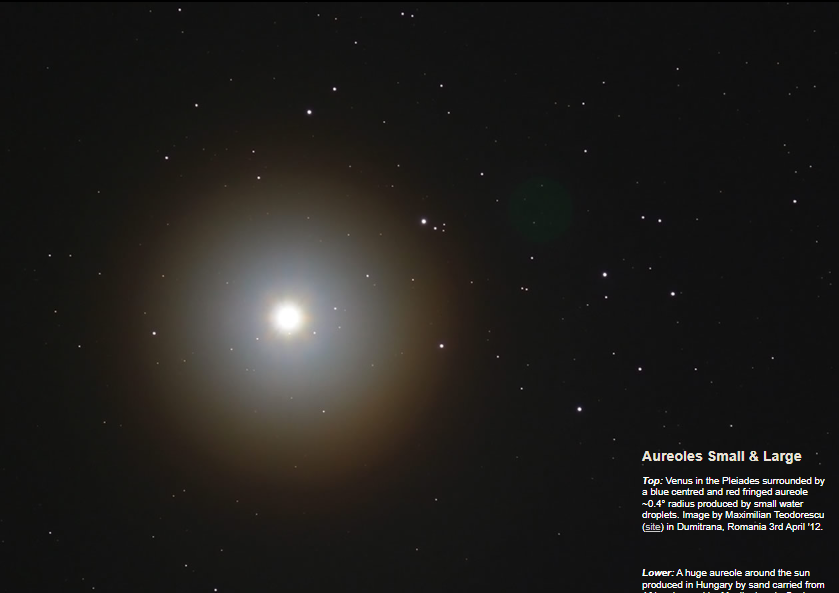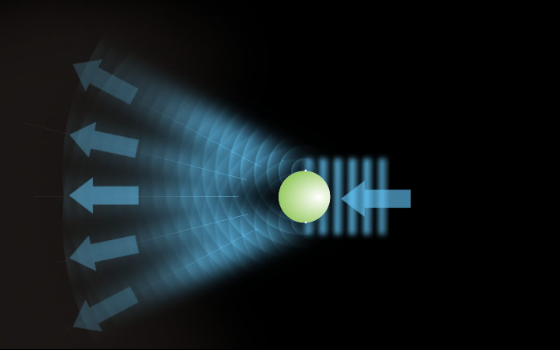OPOD - Aureoles large and small
OPOD - Aureoles: Small and Large
Aureoles are fascinating optical phenomena that can be observed in the Earth's atmosphere. They are created by the scattering of light from various particles suspended in the air, such as water droplets, sand, pollen, and even pollutants. The size and appearance of aureoles can vary depending on the nature and size of the particles involved. In this article, we will explore the captivating world of aureoles, both small and large, and delve into their intriguing characteristics.
Small Aureoles: Delicate Beauty
Small aureoles are typically produced by tiny water droplets in the atmosphere. These droplets scatter light, causing a phenomenon known as diffraction. When sunlight passes through these droplets, it bends and spreads out, resulting in a beautiful display of colors around the source of light, such as the sun or the moon.
The size of small aureoles is relatively compact, with a radius of around 0.4°. This means that they appear as a narrow band of colors encircling the celestial object. The central region of the aureole often exhibits a bluish hue, while the outer fringes may display shades of red. This coloration is a result of the scattering properties of the water droplets.
Large Aureoles: A Grand Display
In contrast to their smaller counterparts, large aureoles are created by bigger particles, such as sand or dust. These particles can be carried over long distances by atmospheric currents, often originating from distant regions like Africa. When these particles are present in significant quantities, they can give rise to expansive aureoles that envelop the celestial bodies.
One remarkable example is the occurrence of a massive aureole around the sun due to the presence of African sand particles in Hungary. The diameter of this dusty disk reached an astonishing 18-20° radius, creating a truly extraordinary spectacle. Normally, these African dusty airmasses are observed from late April to late June, making this early appearance particularly noteworthy.
The Influence of Particle Size
The size of the particles responsible for aureole formation plays a crucial role in determining the appearance of these optical phenomena. In general, the larger the particles, the smaller the aureole. This relationship stems from the scattering behavior of light. When objects of similar size are present in the atmosphere, the scattering occurs predominantly at the periphery of these objects.
When the particles are approximately equal in size, a central aureole is surrounded by concentric colored rings, collectively known as a corona. The corona exhibits a mesmerizing pattern of colors, with different wavelengths of light being diffracted and dispersed to varying degrees. However, in certain cases, only the aureole itself may be visible, devoid of the corona.
Ubiquitous Presence
Aureoles are a constant presence around the sun unless the air is exceptionally free of dust and aerosol particles. These optical phenomena are a testament to the ever-present scattering and diffraction of light in our atmosphere. Whether it is the microscopic water droplets suspended in clouds or the larger particles carried across continents, aureoles offer us a glimpse into the intricate interplay between light and matter in our everyday environment.
In conclusion, aureoles, both small and large, provide us with captivating displays of light and color in the atmosphere. From the delicate blue-centered and red-fringed aureoles created by small water droplets to the awe-inspiring expansive aureoles produced by sand and dust particles, these optical phenomena never fail to captivate our imagination. So, keep your eyes on the sky and be ready to witness the enchanting beauty of aureoles whenever nature decides to unveil its atmospheric wonders.

Aureoles Small & Large
Top: Venus in the Pleiades surrounded by a blue centred and red fringed aureole ~0.4° radius produced by small water droplets. Image by Maximilian Teodorescu (site) in Dumitrana, Romania 3rd April '12.

Lower: A huge aureole around the sun produced in Hungary by sand carried from Africa. Imaged by Monika Landy-Gyebnar.
"On 5th April we had much African dust above Hungary, very early this year... I noticed it late in the morning and the diameter of the dusty disk around Sun was 18-20° radius at maximum size. Usually these African dusty airmasses come here from late April to late June, so this appearance is really early."
Images ©Maximilian Teodorescu and Monika Landy-Gyebnar

Droplets, sand, pollen, pigs with wings - all can produce aureoles. The larger the object the smaller is the aureole.
Light is scattered mostly from the periphery of the objects. When they are all more or less equal sized the central aureole is surrounded by coloured rings - a corona = otherwise we see only the aureole which may not even be red fringed.
An aureole is always present around the sun unless the air is exceptionally free of dust and aerosol.
Note: this article has been automatically converted from the old site and may not appear as intended. You can find the original article here.
Reference Atmospheric Optics
If you use any of the definitions, information, or data presented on Atmospheric Optics, please copy the link or reference below to properly credit us as the reference source. Thank you!
-
<a href="https://atoptics.co.uk/blog/opod-aureoles-large-and-small/">OPOD - Aureoles large and small</a>
-
"OPOD - Aureoles large and small". Atmospheric Optics. Accessed on November 26, 2024. https://atoptics.co.uk/blog/opod-aureoles-large-and-small/.
-
"OPOD - Aureoles large and small". Atmospheric Optics, https://atoptics.co.uk/blog/opod-aureoles-large-and-small/. Accessed 26 November, 2024
-
OPOD - Aureoles large and small. Atmospheric Optics. Retrieved from https://atoptics.co.uk/blog/opod-aureoles-large-and-small/.